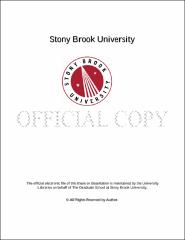| dc.identifier.uri | http://hdl.handle.net/11401/77703 | |
| dc.description.sponsorship | This work is sponsored by the Stony Brook University Graduate School in compliance with the requirements for completion of degree. | en_US |
| dc.format | Monograph | |
| dc.format.medium | Electronic Resource | en_US |
| dc.language.iso | en_US | |
| dc.publisher | The Graduate School, Stony Brook University: Stony Brook, NY. | |
| dc.type | Dissertation | |
| dcterms.abstract | This dissertation explores how television, its programs, its status as a domestic material object, its technologies, and its presence as a motif in literature, TV series and film, contribute to theorizations and representations of memory of the dictatorship in post-Pinochet Chile. At the same time, individual and collective memories affect television’s representations of the past. Specifically, I look at intersections between familial, generational and medial memory practices of addressing trauma in essays, feature film, television, novels, and documentary films. I identify a range of self-referential and performative techniques of (post)memory particular to the Chilean “children of the dictatorship.†Although the texts’ meta-textual practices range from self-promotional to self-reflexive, all point to art and imagination as therapeutic processes that work through layers of trauma. The first chapter analyzes Diamela Eltit’s “Las dos caras de la Moneda†through Dori Laub’s work on witnessing to propose that television serves as a potential witness. Next, I look at the multifaceted role of television in the TV series Los 80 as a porter of restorative and reflective nostalgia (Svetlana Boym). Finally, I apply Allison Landsberg’s “prosthetic memory†to No to discuss the film’s potential for empathic viewership. Chapter 2 examines practices of collecting in the novels Formas de volver a casa (Alejandro Zambra) and Fuenzalida (Nona Fernández) through Walter Benjamin’s ideas on collection. The novels’ meta-textual impulses are examples of the performative index and role of imagination in (post)memory (Marianne Hirsch). These novels consciously highlight the fictionalization of memory and vindicate the perspectives of indirect victims. The third chapter studies (post)memory in the documentaries Mi vida con Carlos (Germán Berger-Hertz) and El eco de las canciones (Antonia Rossi) through José van Djick’s “mediated memories†and Stella Bruzzi’s “performative documentary.†An audiovisual letter, Mi vida performs (post)memory associated with the disappeared through a mixture of documents and media. El eco, an audiovisual diary, employs performative collage aesthetics to process traumas of exile by juxtaposing materials and technologies. In these narratives, TV becomes a tool of memory and healing, as a family companion, a generational marker, and a source of aesthetic material. | |
| dcterms.available | 2017-09-20T16:53:23Z | |
| dcterms.contributor | Firbas, Paul | en_US |
| dcterms.contributor | Pérez-Melgosa, Adrián | en_US |
| dcterms.contributor | Vernon, Kathleen | en_US |
| dcterms.contributor | Burgos-Lafuente, Lena | en_US |
| dcterms.contributor | DiGiovanni, Lisa. | en_US |
| dcterms.creator | Osborne, Elizabeth | |
| dcterms.dateAccepted | 2017-09-20T16:53:23Z | |
| dcterms.dateSubmitted | 2017-09-20T16:53:23Z | |
| dcterms.description | Department of Hispanic Languages and Literature. | en_US |
| dcterms.extent | 286 pg. | en_US |
| dcterms.format | Application/PDF | en_US |
| dcterms.format | Monograph | |
| dcterms.identifier | http://hdl.handle.net/11401/77703 | |
| dcterms.issued | 2015-12-01 | |
| dcterms.language | en_US | |
| dcterms.provenance | Made available in DSpace on 2017-09-20T16:53:23Z (GMT). No. of bitstreams: 1
Osborne_grad.sunysb_0771E_12607.pdf: 137745862 bytes, checksum: 919b482a8c9e9e8fca846ef2011d65cb (MD5)
Previous issue date: 1 | en |
| dcterms.publisher | The Graduate School, Stony Brook University: Stony Brook, NY. | |
| dcterms.subject | Latin American literature | |
| dcterms.subject | Chile, family, hijos de la dictadura, memory, post-dictatorship, television | |
| dcterms.title | Remembering the Remote: Family, Memory, and Television in Post-Pinochet Chilean Culture | |
| dcterms.type | Dissertation | |

